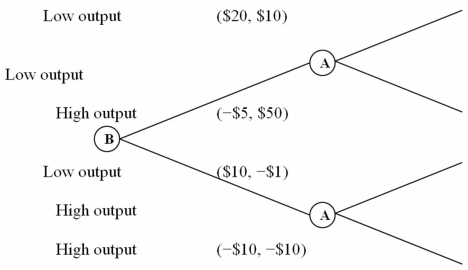Multiple Choice
Using the following sequential-move production game, determine whether player B has a first-mover advantage and identify the strategy that leads to that advantage: 
A) Player B has a first-mover advantage. The equilibrium strategies leading to an advantage are {(low output) ; (if low output, high output) , (if high output, high output) }.
B) Player B has a first-mover advantage. The equilibrium strategies leading to an advantage are {(low output) ; (if low output, high output) , (if high output, low output) }.
C) Player B has a first-mover advantage. The equilibrium strategies leading to an advantage are {(high output) ; (if low output, high output) , (if high output, low output) }.
D) Player B does not have a first-mover advantage in the game.
Correct Answer:

Verified
Correct Answer:
Verified
Q11: A single firm that charges the monopoly
Q12: A network linking six users is typically:<br>A)
Q24: Firms that can effectively price discriminate can
Q28: Consider a two-way network with 1,000 users.Adding
Q30: Refer to the following payoff matrix: <img
Q33: Suppose the inverse market demand is given
Q43: Penetration pricing is a way to:<br>A) raise
Q46: Limit pricing is:<br>A) a strategy whereby a
Q70: Consider an incumbent that is a monopoly
Q86: Which of the following is a strategy